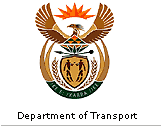 |
INTRODUCTIONOverview of the Rail Freight System of KwaZulu-NatalThe rail freight system of KwaZulu-Natal (KZN) is an
important element of the South African transportation
system and is a significant factor in the movement of
freight within and through the province to destinations in
the interior, both within and beyond South
African borders.
As part of its functionality in terms of the National
Land Transport Transition Act (NLTTA), the KZN Department
of Transport (KZN:DOT) needs to take an holistic view of
all freight transport facilities in KZN, and establish
their value within the context of an overall
“freight
plan” for the province. Considering the established
freight transport corridors of the province, a short,
medium and long-term utilisation plan for railway
stations, sidings and facilities should be developed
jointly by the KZN:DOT and the railway administration.
Approximately 20 million tons of general cargo was
transported by
rail across KZN over four important mainline arterial
routes running from Durban to Volksrust, Ladysmith to Van
Reenen and Harrismith, Glencoe to Vryheid, Durban to
Golela (and Swaziland), as well as over one mainline
standard
branch from Durban to Port Shepstone and Simuma. There
are a number of secondary branch lines including those
running east and west from Pietermaritzburg, Ennersdale to
Bergville, Tendenka to Hlobane, and Empangeni to
Nkwalini.
In addition, the Richards Bay ‘heavy haul’
Coal
Line
contributed to both export and domestic traffic.
Of the overall total, over 7 million tons consisted of
transit traffic, moving from one province through KwaZulu-
Natal to other provinces, as well as one
international connection with Swaziland. Rail is a significant
provider of transportation capacity; however, its market
share of general freight traffic has declined in recent
years. It is necessary for the province to monitor this
situation. By virtue of the provincial requirement in
terms of the NLTTA to provide an integrated modal
transport and freight transport plan, it will be necessary
for the province to monitor the market share of freight
cargo carried by the different modes of transport.
The KwaZulu-Natal Freight Transport Databank can
facilitate this process.
Some three years ago, the national government at cabinet
level
approved a general policy to encourage greater use of rail
transport. This resulted in a complete evaluation of the
assets, liabilities and market status of the railway
administration. The recently announced R 65 billion
recapitalisation programme is the first major state
intervention to address declining rail cargoes. For
KwaZulu-Natal to ensure maximum benefit from this railway
investment programme, joint planning will be necessary.
An increase in rail market share assumes that the
substantial investment planned for rail infrastructure,
rolling stock and locomotives will facilitate a
significant
improvement in rail service delivery. It must be
appreciated that, as the railway investment
programme has barely commenced, there will be some delay
before an overall improvement in service delivery is
evident. In this respect the administration is likely to
follow a targeted marketing approach, concentrating
initially on specific commodities or areas. The province
needs to ensure that the targeted areas for improved
performance are in line with its developmental
plans.
|
 |



